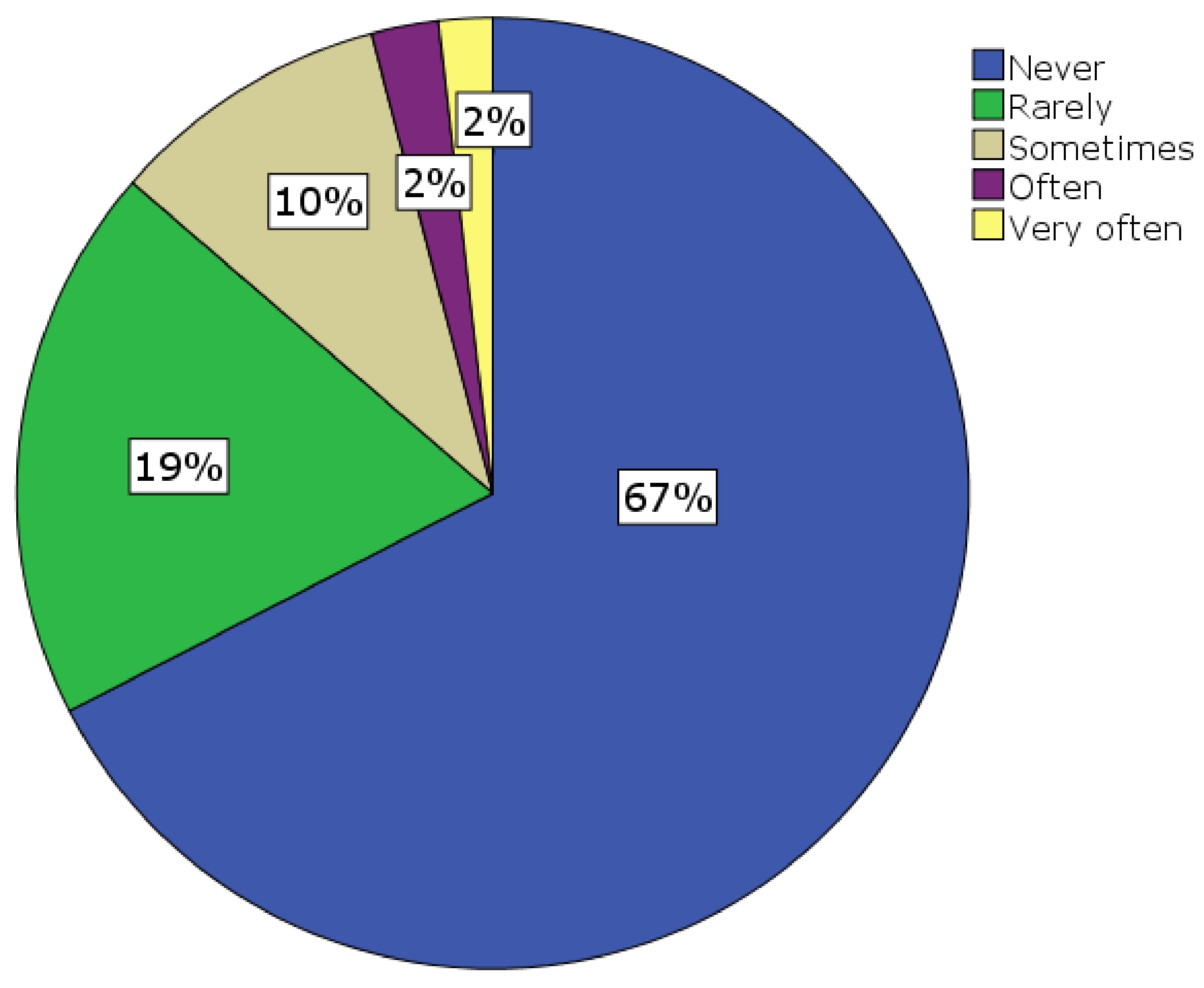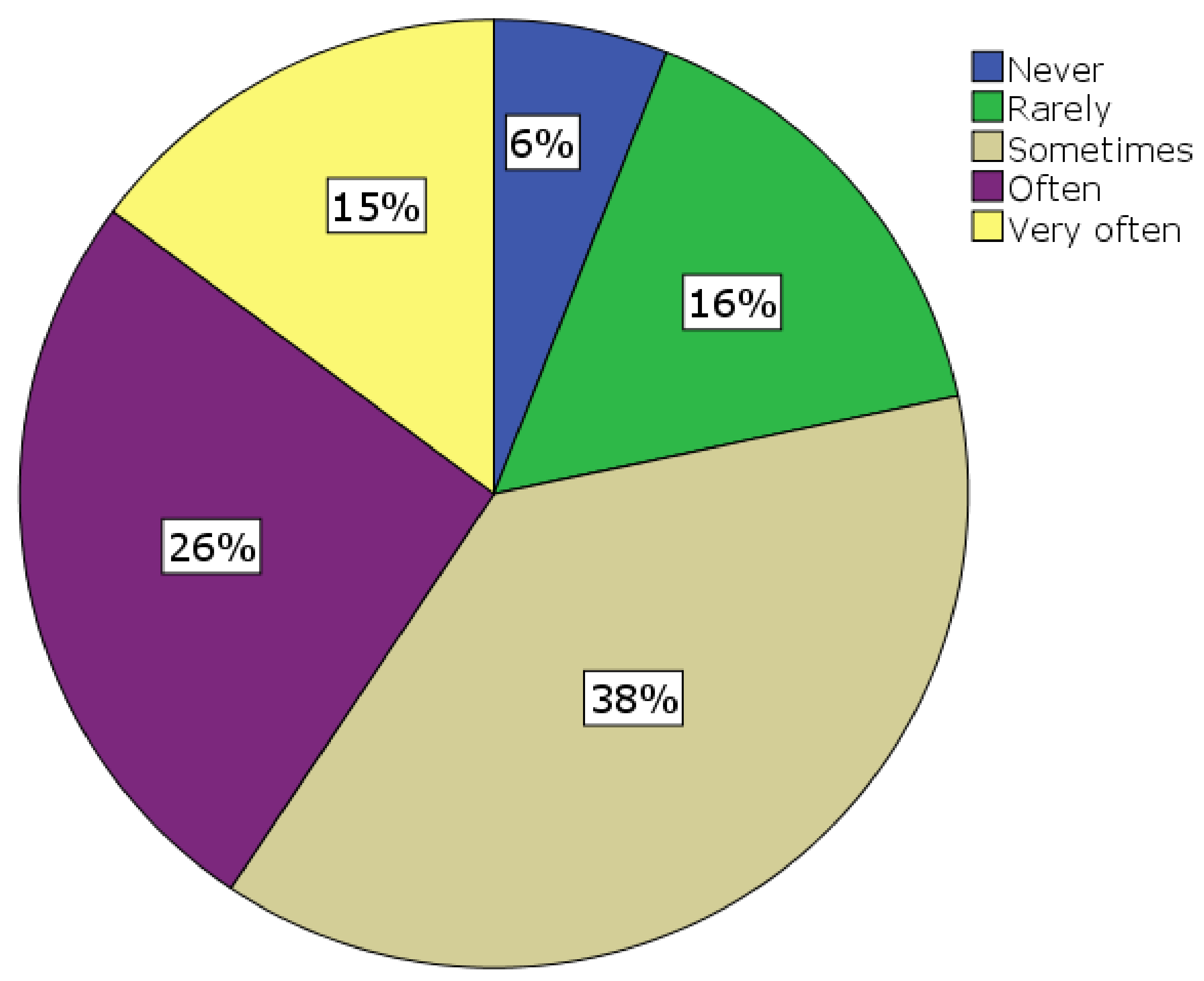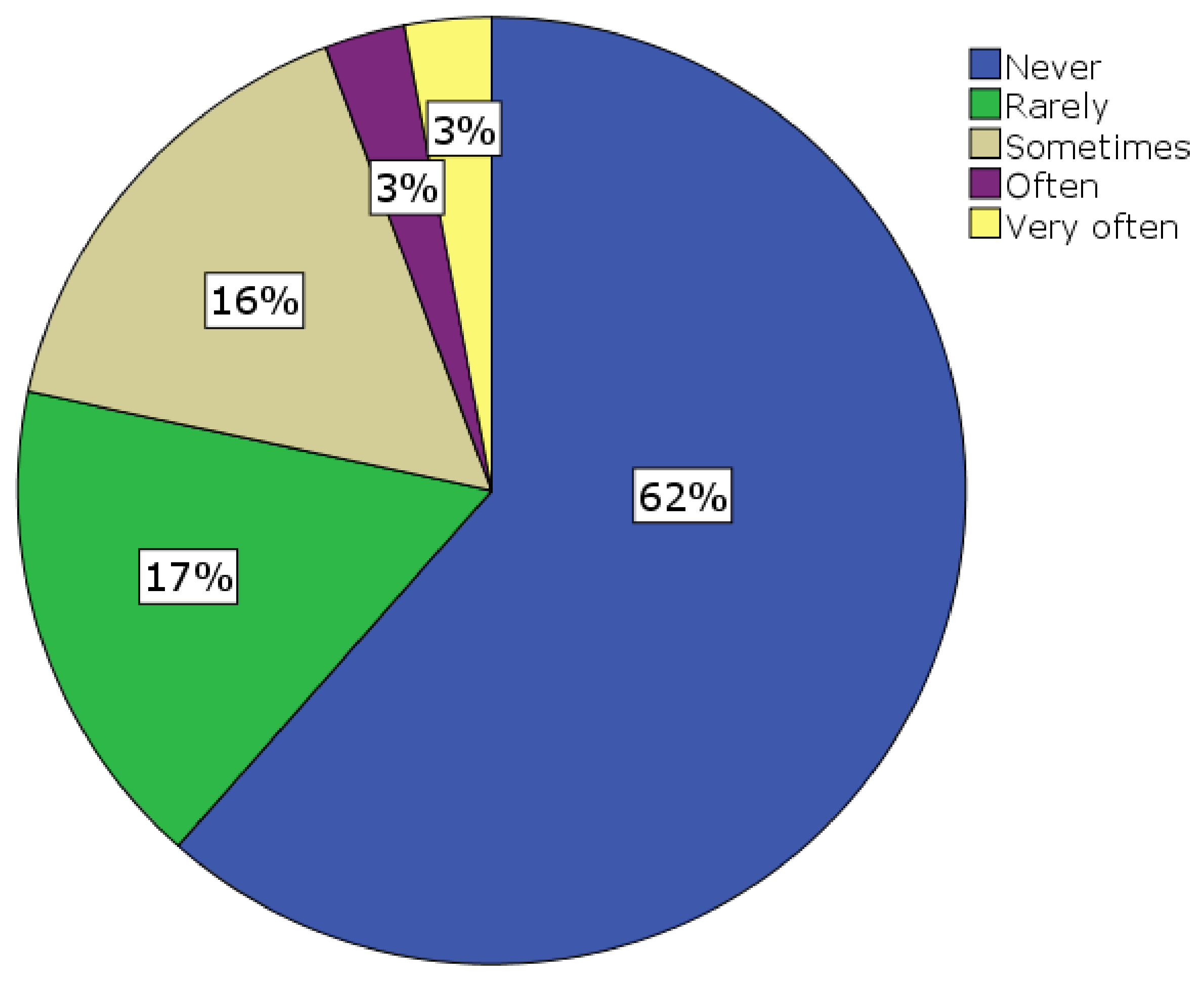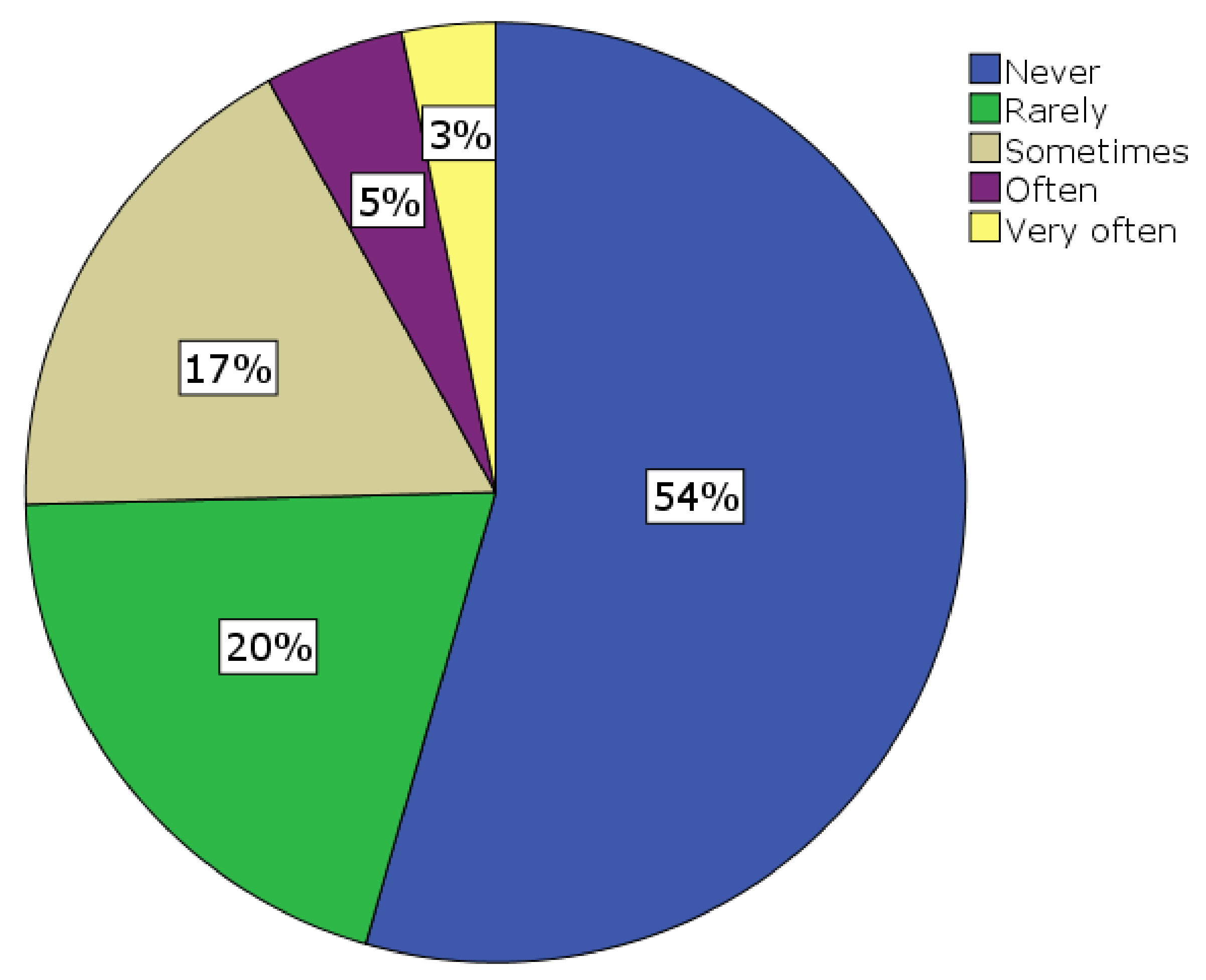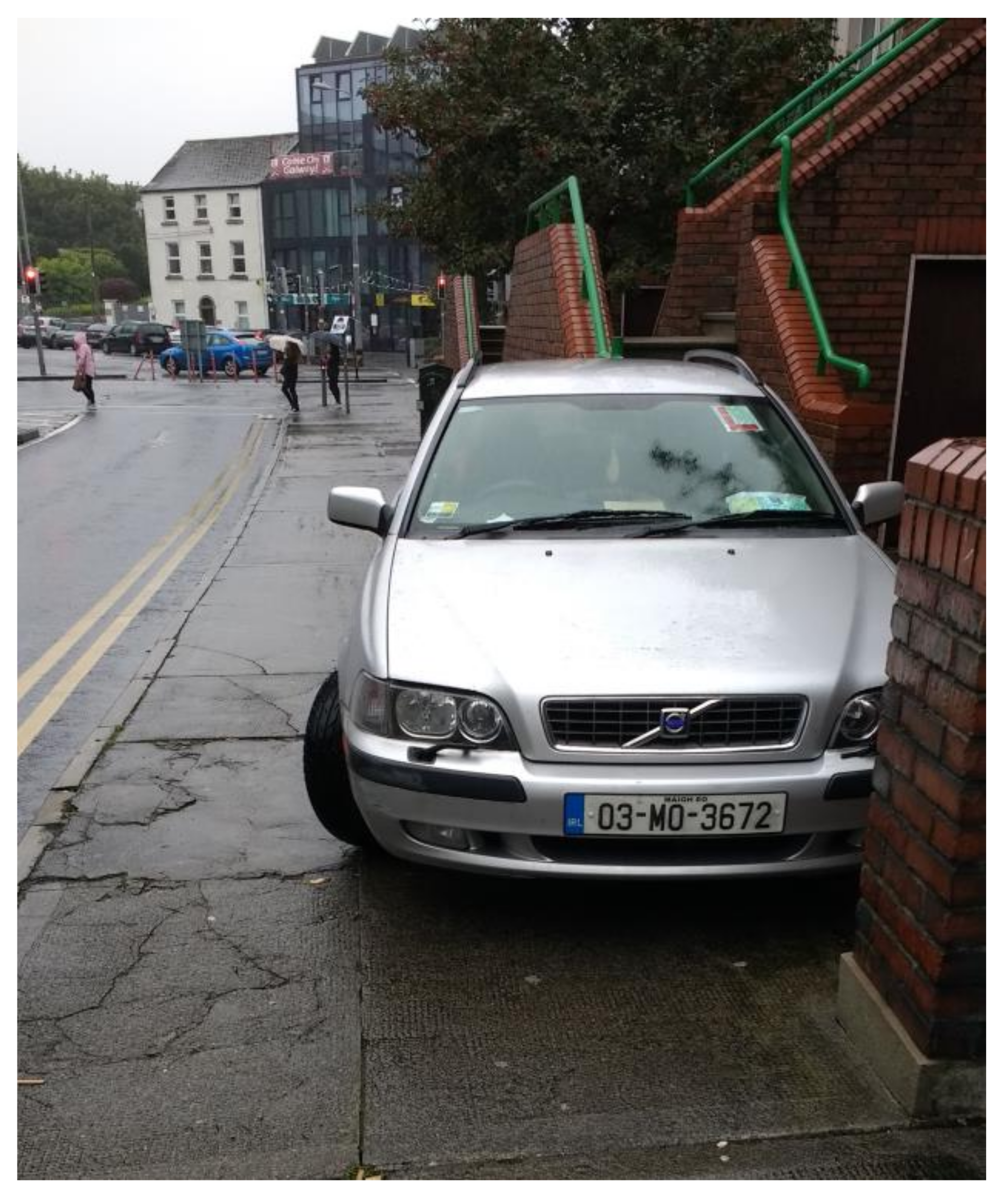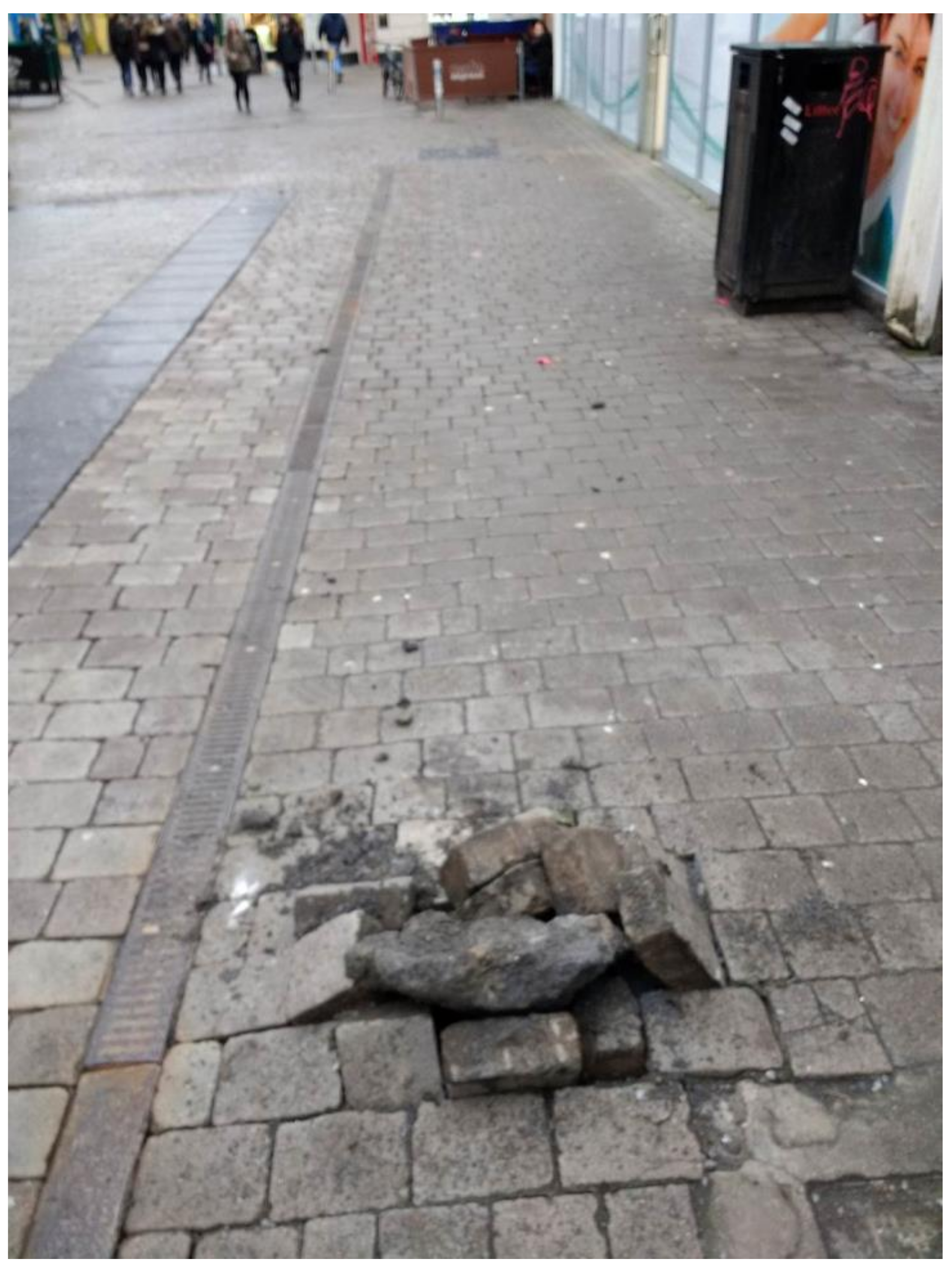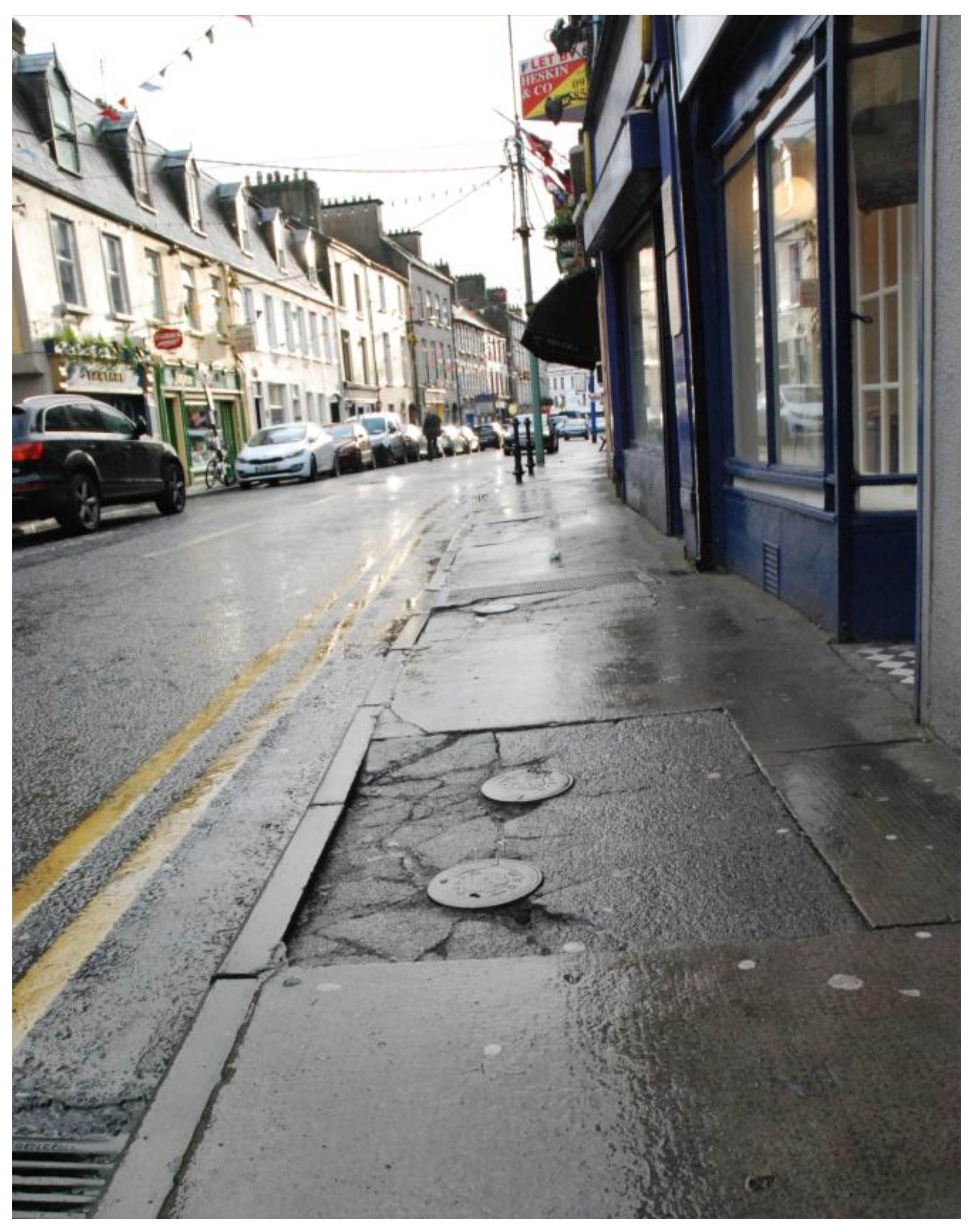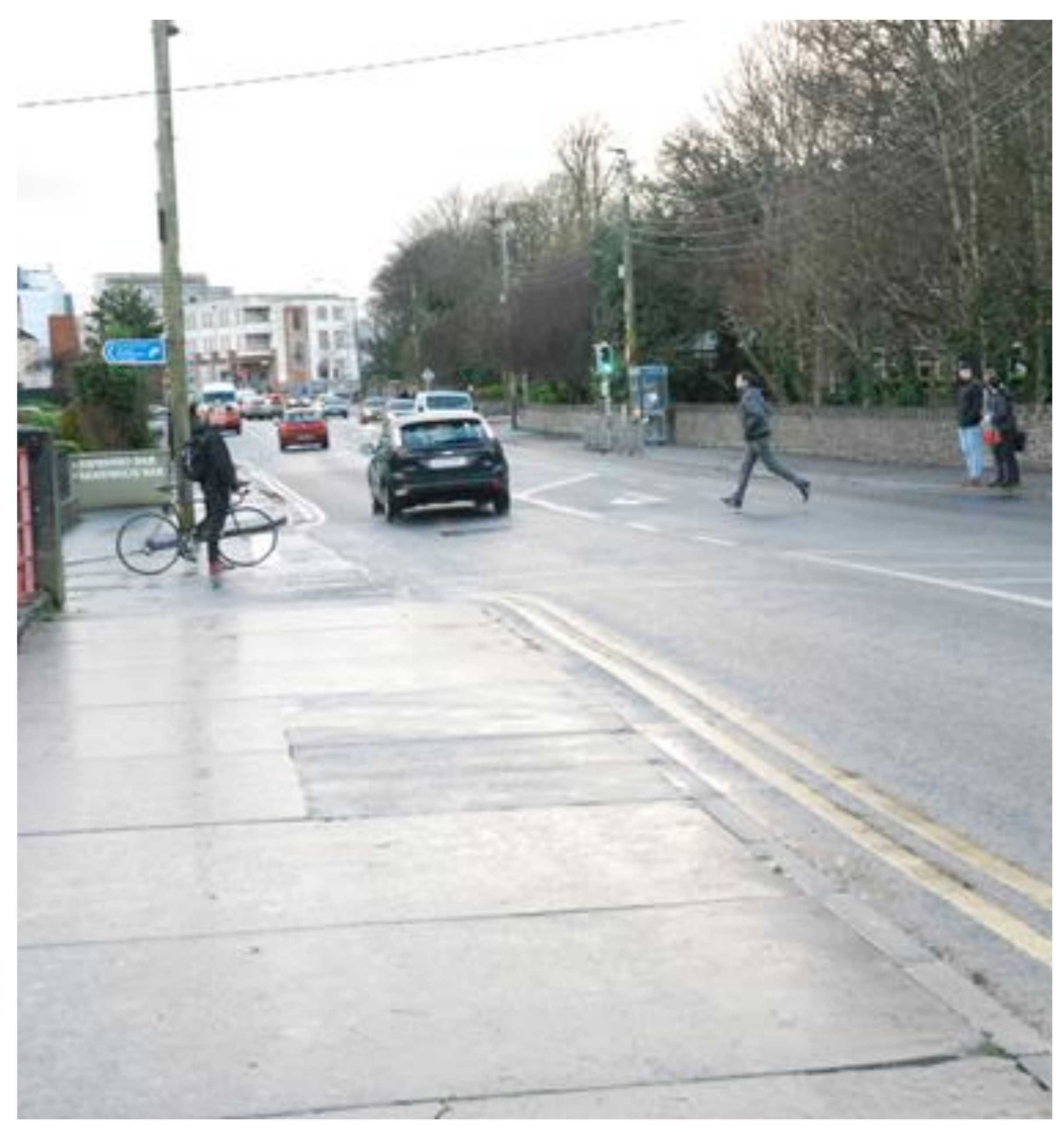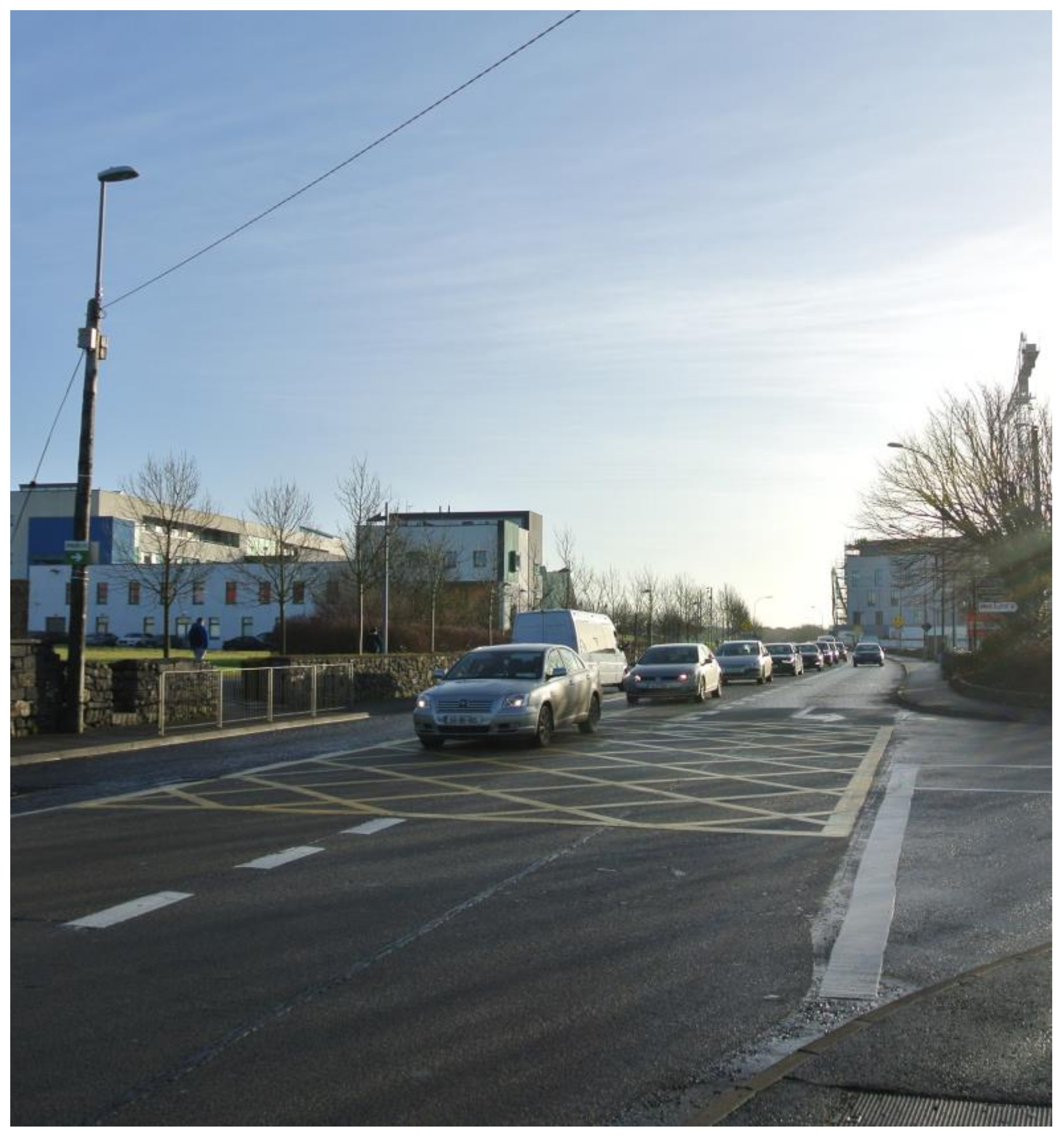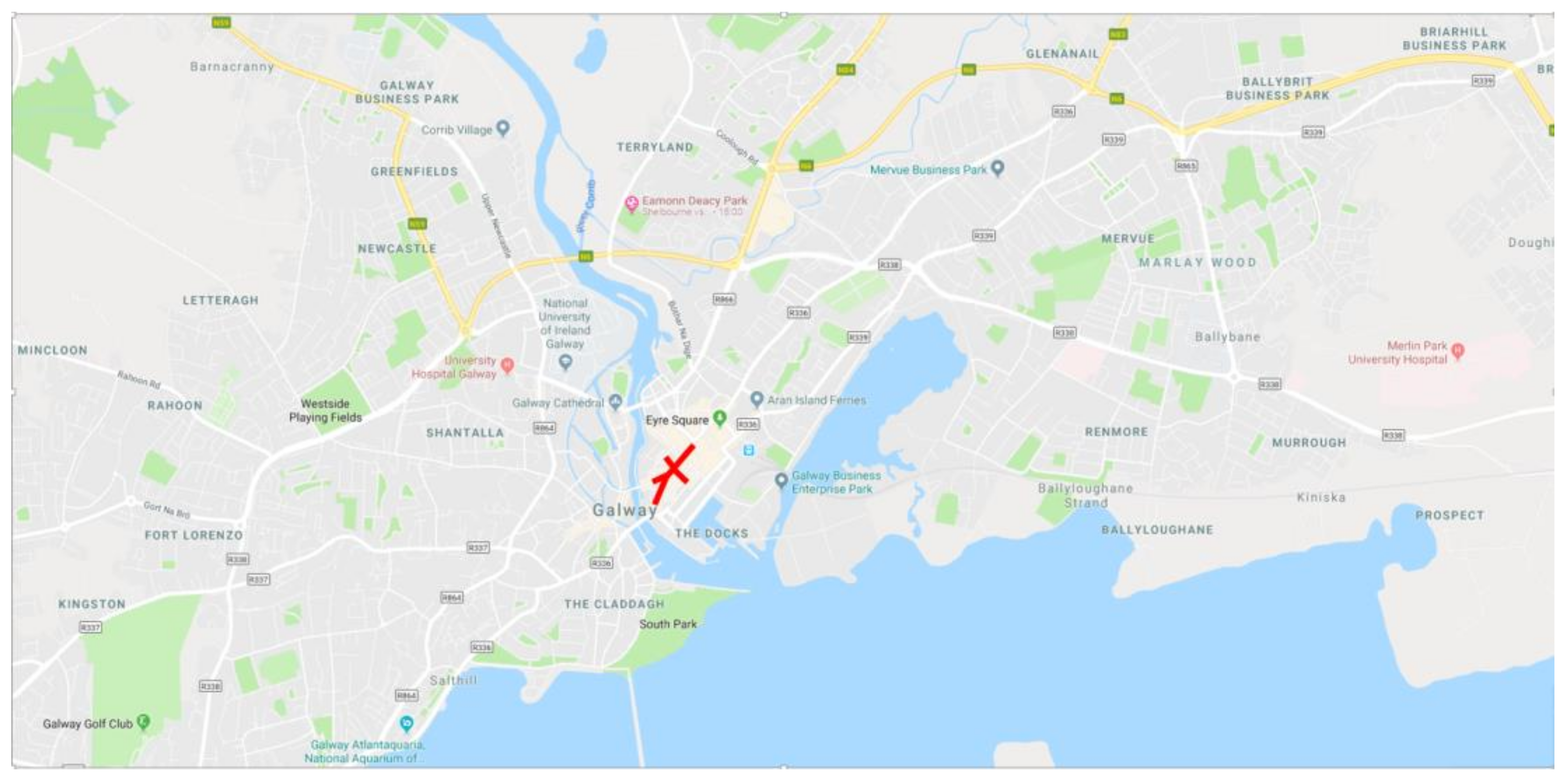1. Introduction
Walkability is a measure of how friendly, safe, accessible, and pleasant an area is for walking and in many ways is the cornerstone to an urban area’s efficient ground transportation system. To promote this active mobility form, we must strive for agreeable and easy walking distances that meet everyday needs such as access to public spaces, education, shops, places to eat, health services, parks, and recreational facilities and good additional transportation options that allow people access employment opportunities, places to socialise, and further lifestyle choices and opportunities. Public health, sustainability, and even a lagging economy can be boosted by making cities friendlier for pedestrians [
1,
2]. Urban walkability is about ensuring that local environments in towns and cities are more conducive to walking, and issues relating to walkability cross academic and professional disciplines including transportation, environment, engineering, urban planning, and public health [
3]. For decades more progressive urban design thinkers have advocated for more walkable cities [
2,
4,
5] with limited success. How we define walkability has implications for our broad understanding and the design of urban transportation networks and public spaces, yet it is suggested that in the recent past, little effort has been expended to understand how to optimise spaces for pedestrians [
6]. An existing bias in favour of automobility is making any moves towards transforming urban spaces difficult. Automobility remakes these public spaces because of the proliferation of car-only or car-dependent environments [
7], and automobile-oriented values of classical modernism have largely been codified in the transportation and street design standards with which we continue to struggle today [
8]. Challenging the status quo will be an immense cultural and political task, but the case for better design and planning of the pedestrian experience remains strong, and walkability continues to be one of the foundations for sustainable healthy city design [
9].
This paper investigates practices and aspects of walkability with respect to people living in Galway, a city on the West coast of Ireland with a population of 79,504 [
10]. With a significant additional population living in its immediate hinterlands, Galway is an ideal site for investigating issues of walkability, thinking and approaches to transportation, and questions associated with liveability as these relate to small developing cities, towns, and urban/semi-rural settings. Such local studies are essential to our overall understanding as transportation inevitably has detailed local dimensions, which are often undertreated in the literature and can be understood as existing transportation cultures. Using data from the
Mobilities and Liveability in Galway project, collected in Galway during the summer of 2016, this paper seek a more nuanced understanding of issues relating to existing practices and features of walkability and the possible pressures and barriers that exist with regards to the further development of walking in the city as an agreeable experience and a legitimate and pleasurable way of getting about. Such research has the potential to better inform urban design and planning, while appreciating the unique cultural and social contexts at play in promoting and supporting walking in and around urban environs.
2. A Look at the Literature on Walkability
There is growing interest in better understanding the influence of features of the built environment on habitual physical activity [
11,
12,
13,
14,
15,
16,
17]. Publications on this topic have come from a wide range of disciplines, and reviews that synthesise empirical studies help illuminate the evidence base and inform current research [
18]. What is becoming evident is that in most Western countries, a large proportion of the population is not sufficiently active, and the increased prevalence of sedentariness and obesity are a growing public health concern [
19,
20]. Regular walking, like most aerobic activities, is good for individuals because cardiovascular exercise strengthens the heart and lungs, increasing overall fitness. Additionally, more walkable places have the potential to provide mental health benefits [
21,
22]. Improving the built environment to make it easier for people to walk and be physically active is an essential component of increasing physical activity [
23,
24]. There are also a variety of other benefits from greater moves towards walkability in urban areas, including social cohesion, crime prevention, public safety, multimodal traffic safety, and economic rewards [
25]. Walkability is strongly associated with higher housing values in many metropolitan areas [
26]. Planning, which promotes walkability, improves social capital, provides passive security, and leads to a greater sense of community [
27,
28]. Such important positive benefits have implications for policy design and planning, as well as for future research. The prerequisite for the effective design and implementation of approaches to promote greater physical activity, such as walking, is the identification of issues that influence the adoption and maintenance of such active lifestyles. In this respect, local governments and decisionmakers have a crucial role to play in creating environments and opportunities for physical activity and supporting and encouraging active living [
29].
If environmental factors are associated with physical activity levels, then environment-changing interventions will form part of an effective population-level strategy to tackle inactivity and obesity; even if the effects are relatively small, they are likely to reach large groups of people and are likely to achieve sustainable public health outcomes [
18]. A significant reason for lower levels of walking, for instance, is a lack of support for walkers [
30]. Forsyth and Krizek [
31] maintain that combined strategies, such as infrastructure, community design, pricing, and enforcement of traffic regulations, work better to increase walking in general. The motivation to walk also depends on personal and household characteristics, such as age, health status, profession, education, and life cycle, as well as on habits, attitudes, and preferences, but only in the presence of opportunity do the motivational factors become relevant [
32]. Whereas cultural and social influences do play a role in increasing physical activity, individuals are more likely to walk when the built environment is more supportive of such activities. Goodman et al. [
33] found that those living closer to segregated walking infrastructure walk for longer each week. However, while specific planning policies may help people walk more and for longer, their effectiveness in reducing total travel will be at least partially offset by the range of choices available to residents in metropolitan areas [
34].
Yet, a common feature of most cities is that people who use urban spaces for walking have been poorly treated by transportation and urban designers for many decades [
35]; indeed many urban planning systems do not encompass health issues [
36]. Diminishing space, obstacles, noise, pollution, safety concerns, risk of accident, and generally poor conditions are typical for city dwellers, which in turn has reduced the opportunities for walking as a form of transportation and also placed the social and cultural functions of city space under siege [
4]. Such observations are not new. In her acclaimed book
The Death and Life of Great American Cities, Jane Jacobs forecasted that the dramatic increase in automobile use and the urban planning ideology of modernism would put an end to public space and city life, resulting in lifeless cities bereft of people [
5]. Moreover, socially and ecologically destructive suburban sprawl has greatly increased over the recent decades, augmenting car-dependency that works against the evolution of liveable and walkable communities and cities. Such planning has become the norm, and all too often, promising efforts towards sustainability-oriented planning initiatives succumb to entrenched social values, gridlocked institutions, or economic and political forces that promote self-interest and short-sightedness [
9]. It has been suggested that:
[e]xponential traffic growth has affected even more both the distribution of land values and the physical condition of our active urban cores. The city itself now seems to be in a state of rapid disintegration because of this impact of motor traffic.
There appears little respite for pedestrians on city streets because we have been taught to believe that large segments of urban space belong solely to the car. However, in some more progressive cities and towns, this trend is being reversed with moves towards thoughtful innovations of use varying with time. Some of promising initiatives include the following: reducing or eliminating traffic into narrow city centre streets (A number of major European cities have begun moves toward car-free neighbourhoods, including Madrid, Paris, Hamburg, Helsinki, Milan, and Copenhagen.); traffic calming measures, such as speed bumps, clear crossing aids, and pedestrian signals; moving towards aesthetics and placemaking by way of public art, street furniture, fountains, trees and other decorative features; creating public parks, plazas, and other spaces accessible to and usable by the public; and developing greenways and green streets (A green street uses green stormwater infrastructure to capture and manage rain or melting snow (runoff) directly from the street. Green streets allow runoff to soak into soil, filtering out pollutants like oil, and reduce the amount of stormwater making its way into combined sewer pipes, which reduces the combined sewer overflows that degrade waterways). Well-designed residential streets, separation from vehicle traffic, pedestrian network connectivity, and parks and ‘bounded openness’ all contribute to the attractiveness of walking environments [
38]. Temporal changes in the use of public space, applied in incrementally more comprehensive patterns, may well be key to successfully reducing transportation-caused carbon emissions and meeting environmental goals that otherwise seem to elude the developed and developing worlds [
39]. All these design initiatives share one major focus: reducing the impact and need for automobile use.
While there have been significant international efforts to developing walkability measures [
40,
41,
42,
43], little is evident with respect to research focussed on walkability in Galway upon which the authors might build. A qualitative study that investigated modal shifts among the workforce of a large employer in Galway found perceived safety risks to be an important barrier to walking [
44]. National statistics on walking are available from the Central Statistics Office (CSO), but little research exists with regards to more in-depth sociological analysis as to why people choose a particular mobility mode or if, indeed, people even perceive walking as a legitimate mode of transportation. The National Travel Survey, for instance, indicated that while approximately 19% of journeys were less than 2 km, fewer than 15% were accomplished by walking [
45] (Moreover, only 1.6% of these journeys were completed by bicycle.). Proportionally, more commuters walked to work in Galway with 17% walking, compared to 14.5% in Dublin and Waterford and just 4.6% in the aggregate rural area [
46]. The adoption of
Smarter Travel [
47] represented a possible sea-change in Irish transportation policy thinking, placing priority on improving sustainability by recognising the need for safe, direct, and coherent walking and cycling networks. But little evidence of any serious move to incorporate land use and urban planning into sustainable transportation policy thinking is evident, and departmental silo-thinking continues to permeate much of the decision-making in this regard [
48].
3. Research Method
A mixed method approach, quantitative and qualitative, was adopted for this study. The quantitative data was gathered as part of the
Mobilities and Liveability in Galway research project, an innovative cooperative teacher/student investigation, which sought to capture people’s opinions, views, and understanding of key issues related to transportation and liveability in Galway, Ireland. Data collection was carried out by undergraduate research students from the School of Political Science & Sociology at the National University of Ireland Galway over a five-month period in 2016. The
Mobilities and Liveability in Galway project was a quantitative study comprised of a questionnaire of 43 questions on issues related to transportation, mobility, and liveability, and eight demographic questions (The full questionnaire is available for download from
www.ssrc.ie/docs/mobilities_&_liveability_galway.pdf). The questions selected were a result of much deliberation and were based on local transportation debates and media coverage and discussions (For instance, the statement on traffic lights was directly linked to the recent transformation of key junctions in the city from large roundabouts to traffic light systems. This is has led to complaints of traffic delays in the city, particularly by car drivers. Other issues such as additional road building and parking and attitudes toward cycling and bus lanes are all ongoing concerns for citizens, advocacy groups, the local media, and in decision-making circles.).
A stratified probability sampling approach was employed, with the urban population of the city broken into its three respective electoral districts: Galway City Central (24.96%), Galway City East (39.83%), and Galway City West (35.21%). Data collection was initially carried out by the widespread localised promotion of the questionnaire via social media and made available through the free and open source online platform LimeSurvey. Efforts at limiting bias were made, including avoiding the assistance of various local transportation advocacy and lobby groups. Concerns about the asymmetry of responses and, indeed, the digital divide prompted researchers to limit these online participants. After the preliminary online collection phase, the questionnaire was then administered through face-to-face interviews in targeted areas of the city to satisfy the sampling method adopted. Attempts were made to limit, as much as possible, spatial biases by using a systematic sampling method of these selected areas. Over 400 (
n = 416) fully completed questionnaires and 38 incomplete questionnaires were gathered for an overall total of
n = 454. The percentage breakdown of collected questionnaires were: Galway City Central (27.16%,
n = 113), Galway City East (38.70%,
n = 161), and Galway City West (34.14%,
n = 142). The data collection period ran from 9 June 2016 to 9 November 2016, at which point the responses were input into SPSS (IBM Corp. Released 2013. IBM SPSS Statistics for Windows, Version 22.0. Armonk, New York, NY, USA: IBM Corp) to enable data analysis. An interesting snapshot comparison (see
Figure 1 and
Figure 2) between the 2011 CSO figures for Galway City and the findings from this particular study would suggest that our sample is generally representative of the people living in Galway and how they travel to work or study.
A number of brief follow-up interviews were carried out (
n = 6) in an attempt to unearth reasons behind the discrepancy the study results and the authors’ own personal experiences. This, autoethnography was used as an additional supplementary research approach to the previously described quantitative method. Autoethnography is a qualitative approach to research and writing that seeks to describe and systematically analyse personal experiences in order to better understand specific cultural practices, and this approach challenges canonical ways of doing research [
49]. A researcher uses tenets of autobiography and ethnography to do and write autoethnography, and one of the key advantages of personal narratives is that they give us access into the authors’ private worlds and are a rich source of data. Another advantage is the ease of access to data because the researcher calls on his or her own experiences as the source from which to investigate a particular phenomenon [
50].
4. Participant Assessment of Walkability in Galway
As part of the overall Mobilities and Liveability in Galway research project, a number of explicit questions focussed on various aspects of walkability were asked of participants. This was an attempt to understand participant perceptions and attitudes towards walking in an urban context. Broadly, the assessment of Galway as walkable and pedestrian-friendly was a positive one. Overall, 64% agreed or strongly agreed that Galway is a pedestrian-friendly city, and 73% were satisfied or very satisfied with the design and appearance of their neighbourhoods. Generally, 79% were satisfied or very satisfied with their neighbourhoods as a place to walk, and 76% felt safe from crime and antisocial behaviour when walking. Additionally, 76% were satisfied or very satisfied with the noise levels in their neighbourhood, as were 79% with the air quality. Furthermore, 61% were satisfied or very satisfied with the amount of traffic, and 72% were satisfied or very satisfied with the access to basic services such as shops, public transport, sporting facilities, and other such amenities. These results suggest high overall levels of satisfaction with some elementary aspects of walkability. However, an important caveat to these finding is the low percentage of respondents who elect to walk on their commute to and from work or study (Only 18% of respondents walk to and from walk or study on a regular basis.). Is it easier to suggest that Galway is walkable and pedestrian-friendly when viewed from the comfort of your private vehicle?
In attempting to uncover a more meaningful understanding and appreciation of issues related to walkability and the main pressures and barriers to promoting and increasing this active mode of travel, another set of questions directly related to impediments to more regular walking was asked (see
Figure 3,
Figure 4,
Figure 5,
Figure 6,
Figure 7,
Figure 8,
Figure 9 and
Figure 10). Disability or poor health generally does not prevent people from walking, but time constraints and bad weather are significant barriers to increased walking in Galway. In addition, being self-conscious about appearance or having no one with which to walk also do not, in general, prevent people from walking, but a lack of energy is a more significant hindrance for individuals. Feeling unsafe or vulnerable or the condition of pathways and pavements are also not highly significant pressures to walking in and around Galway. Hence, a lack of energy, time constraints, and poor weather all significantly contribute to less walking for participants of this study. But how do these findings relate to the authors’ own experience of walking in and around Galway?
So what could account for the discrepancy between the positive and upbeat assessment of walkability in Galway in the study and the authors’ own real and practical experiences of walking in and around the urban environment for many years? In an attempt to uncover specific reasoning behind these inconsistencies, a number of brief follow-up interviews (n = 6) were conducted. Two structured questions were asked of participants: ‘in the context of Galway, when you think of pedestrian what first comes to mind?’ and ‘do you believe walking is a legitimate form of transport?’ The rationale behind the development of these questions was principally based on discussions undertaken about the findings with a number of colleagues and local sustainable transportation advocates, who, on examining the questionnaire terminology and wording, were critical of the text used. While not rigidly scientific in nature, these follow-up interviews do provide some additional considerations regarding the perception and meaning people ascribe to walkability in the urban context of Galway.
The results of these brief interviews were illuminating and gave the authors’ reason to reflect. The most prominent notion that came to mind (n = 4) with regards to the word ‘pedestrian’ for those interviewed were the cobblestoned city centre streets, which have restricted motorised transportation solely to deliveries for a number of hours in the morning. (These streets (i.e., Williamgate Street, Shop Street, Abbeygate Street Upper and Lower, Shop Street, Mainguard Street, High Street, and Quay Street) have been semi-pedestrianised for a number of decades. When initially proposed it was strongly opposed by business interests in and around the city centre.). We can reasonably assume that many of the research participants, when asked if they believed that Galway was pedestrian-friendly, became mindful, in the first instance, of these walkable streets in and around the city centre. With regards to the question of walking being a legitimate mode of transport, again many felt that walking was a means ‘to get to’ transportation (i.e., walk to the bus or walk to where my car was parked) or a worthy form of recreation or a health activity for people to undertake at specific locations. Galway has a very prominent and renowned seafront promenade in the Salthill area of the city, which people use for recreational walking. Ironically, many people drive to the beginning of this seafront promenade to avail themselves of this promenade.
5. Walking in Galway: A More Critical Perspective
Many of the findings of the
Mobilities and Liveability in Galway study suggest a positive and sanguine attitude towards the geographies and characteristics of walkability in Galway. Indeed, the concerns expressed by participants that limit or restraint individuals from walking relate to the weather and lack of time and energy and do not appear to be directly related to issues such as urban design and the appearance of neighbourhoods, crime, noise, traffic, or air quality. But the authors’ own personal experiences with regards to walkability in Galway conflict significantly with many of the findings of this research. We argue that the movement of people and travel in and around the city is dominated by the automobility regime [
51] and that walking, cycling, and indeed public transport, is subjugated by car-centric approaches, thinking, decision-making, and policy design. Autoethnography is an approach to research that seeks to describe and systematically analyse personal experiences and practices. It affords an ease of access to data because the researcher calls on their personal experiences as the source from which to investigate a particular phenomenon. Thus, in the following section, we outline some of these personal experiences and observations with respect to walkability, and in the discussion section, which follows, we will attempt to square these with the findings from our study.
i. Car-Centric City
The below photographs highlight an everyday issue and difficulty faced by many pedestrians in Galway: unlawful and inconsiderate parking on footpaths and walkways. As shown in
Figure 11, on Forster Street, pedestrians must walk on a damaged part of the path in order to avoid the illegally and thoughtlessly parked vehicle. Ironically, Forster Street is the main thoroughfare from the city centre to Galway City Hall, yet some motorists have little or no fear of penalty for such prohibited parking, nor regard for pedestrians, reflecting the dominance of automobility in the area. In
Figure 12, Raleigh Row is in close proximity to one of the city’s largest primary schools, and parking on the footpaths is one of the area’s most common and prevalent problems. It is worth noting that this phenomenon is not unique to this particular school, and it is a common occurrence at most schools throughout the urban and suburban environments. It creates access problems for the residents of the area and often forces people onto the road to avoid the obstacles, in the form of cars, on the pathways. This occurs at least three times a day as people drop off and collect their children from school. While these are just two recent ‘snapshots’ of daily obstacles faced by pedestrians, the authors contend that inconsiderate and illegal parking is endemic in many areas of the city and has led to anxiety and stress for residents living in these areas, and frequent inconvenience for many pedestrians.
ii. The Conditions for Walking
While the results of the survey suggest that 55 % of participants did not find issue with the conditions of the footpaths in Galway, it is common to find sections of pedestrian pathway in various states of distress and poor repair.
Figure 13 is a photo of one of the main areas of the city centre, Shop Street, a section of Galway’s only pedestrianised space. This area is in dire need of repair due to the effects of wear and tear and the sub-standard materials used in its construction in the late 1990s. Uneven surfaces, for example, are causing problems for pedestrians, and there has been an increase in injuries in the area due to these conditions. In 2014, there were 89 personal injury claims, the majority of which were sprains and other injuries sustained by trips and falls in this area (This cobblestoned pedestrian area of the city remain in poor condition today, and there has been a reported significant rise in compensation claims for injuries sustained in falls and sprains on the uneven surfaces [
52]).
Figure 14 illustrates the condition of a footpath on Dominick Street Lower, leading into the city centre from the West of the city. Here, more uneven surfaces can be seen on the pedestrian pathway. In recent years, this road has been resurfaced twice, but the paths have remained in the same poor state of repair, making it unsuitable for those who choose to get around on foot and dangerous for people with disabilities or parents wheeling buggies or prams. Both of these images capture merely a minor selection of the footpaths in need of repair in and around Galway City.
iii. Disparate Walking
Figure 15 and
Figure 16 are images from outside Galway’s two main third-level institutions, the National University of Ireland Galway (NUIG) and the Galway and Mayo Institute of Technology (GMIT), respectively. With a combined student population of approximately 27,000, they make up a significant cohort of people in the city travelling to and from their respective campuses each day. At University Road, in
Figure 15, there is a set of pedestrian lights in the middle of the junction. However, pedestrians are more inclined to use a ‘natural’ crossing 100 m away, which directly links to Canal Road and the residential areas close by. The logic of locating a pedestrian crossing away from a more natural crossing zone would suggest that planners seek to limit the slowing and stopping of traffic in favour of allowing pedestrians to risk crossing between the various flows of traffic. The Old Dublin Road, in
Figure 16, again highlights the dominance of car-centric design. In addition to this road having a main third-level institution, it is also surrounded by a dense housing and residential area. Despite this, the free flow of motorised traffic is given priority. From the traffic lights closest to GMIT, there is a distance of 1.1 km where there is no pedestrian crossing and a four-junction roundabout to navigate for individuals choosing to walk. Moreover, several key intersections on the outskirts of the city have no pedestrian crossing facilities whatsoever, effectively cutting off some residential areas of the city to pedestrians and people who elect to walk (Examples of these intersections include Joyce Roundabout (widely known as Cemetery Cross), Browne Roundabout on the Seamus Quirke Road, and the Kirwan Roundabout on the Headford Road).
6. Discussion
There appears to be obvious flaws in how the questions were framed and the context in which they were asked, given that we were seeking an understanding of walking not only in a confined city centre locality but throughout the entire urban and suburban regions of the city. The success of both the city centre pedestrianised streets (see
Figure 17) and the seafront promenade at Salthill do, we suggest, account for the positive view of Galway as a pedestrian-friendly city. But walking from the city centre to residential locations, or indeed to and from the seafront promenade, may well be regarded differently if people practiced and experienced this more frequently.
The reality is that the car-centric nature of the transportation decision-making and culture in Galway, coupled with the poor conditions of walkways and the absence of interconnectivity with regards to walking to work, school, or college or for shopping, sporting, or other such leisure activities, makes walking in Galway decidedly unattractive and impractical for many. While some minor efforts towards supporting cycling as an active, healthy, and sustainable form of urban transport appear evident (The promotion of the bike-sharing scheme across the city has increased the number of people cycling; although, there remains strong criticism about the lack of dedicated cycling infrastructure and support for cycling in general from cycling advocacy groups (see
www.galwaycycling.org)), walking remains largely neglected in terms of practical policy and investment. In the Irish Government’s recent
Project Ireland 2040 National Planning Framework [
53], it envisages spending at least €7.3 billion on regional roads and €4.4 billion on public transportation over the next few decades. But, while it proposes a ‘special’ focus on the provision of safe, alternative, active travel options, such as segregated cycling and walking facilities and networks, especially in our cities and towns, no specific project has been outlined nor has funding has been set aside for these active transport schemes. While the latest
Galway Transport Strategy [
54] does highlight an overreliance on private cars and the need to promote more active and sustainable transport options, the recently announced funding allocation for more road building [
53] and the practical ongoing planning of the city (A good example of the ongoing planning difficulties faced by active transportation advocates is the proposed Ardaun urban village development. Cycling campaigners have urged the Galway City Council to abandon half of the planned village and to completely redesign roads or risk creating yet another “inherently car dependent and unsustainable” suburb [
55]) do not bode well for such a transportation approach. Consequently, poorly placed business, street, and road signage, frequently discourteous driving, illegally parked vehicles obstructing pavements, and poorly maintained and rarely cleaned pedestrian surfaces may well remain the norm for the foreseeable future. We have stumbled into this situation because walking is habitually taken for granted, and when the Minister for Transport declared ‘the end of a lost decade for Irish transport’ [
56], he appeared to be finally put an end to
Smarter Travel (Following extensive public consultation,
Smarter Travel provided a new policy framework for promoting low-carbon alternatives to the car, such as walking, cycling, and public transportation use. It furthermore advocated changes in land-use patterns to address growing rural–urban imbalances in transportation infrastructure provision and accessibility) as a sustainable transportation approach in Irish Government policy circles. Such a simple yet important activity such as walking has been largely ignored in the planning process; it is seen as making few demands on the environment and thus appears to need only a minimum of facilities and attention [
57]. In contrast, because automobility make much greater demands on the urban environment, the needs of the car have been more extensively prioritised.
7. Conclusions
Walking, and the concept of walkability, has become a significant focus for many in pursuit of improving the quality of life in urban areas, with the added benefits of improving public and private health and reducing harmful emissions, traffic congestion, and noise associated with excessive automobility. While the notion of walkability is multidimensional, attempts at understanding and measuring the built and social environment that is most conducive to enabling citizens to walk more frequently will lead to improved community relations and support a positive sense of place for people. Indeed, in order to live sustainably into the future, we must begin to rethink urban neighbourhoods and communities in order to promote walkability and other active forms of mobility. This study sought a better understanding of issues relating to existing practices of walkability in Galway and the pressures and barriers that exist with regards to the development of walking in the city as an authentic means of mobility in such a confined environment. Moreover, localised studies are crucial to our understanding of the issue, as transportation has detailed and specific local dimensions, which are recognised as prevailing mobilities cultures and practices. Such understandings will allow policy designers in other towns and cities develop better strategies for promoting and developing active modes of transportation in urban settings. The findings of this study on issues related to walkability diverged from the authors’ own experiences amassed over many years of living and walking the city. What were uncovered were obvious flaws in the wording of the questionnaire and the context of what was asked. There is disconnect between the concept of walking as a legitimate mode of transport and, indeed, viewing the walking experience outside the narrow confines of the pedestrianized, city centre’s cobblestoned streets. For further research in this domain, more cognisance must be placed on the social context of walking and on broadening the scope of focus to include local residential neighbourhoods and their design and connecting the city centre to these residential areas. While urban planning and the built environment are significant elements in terms of promoting and supporting walking other social and environmental dimensions are also crucial, such as the concern we have about the real environmental impacts of our current transportation systems and the dominance of traffic and car parking in and around public spaces. The findings of this research will help provide a better framework for design and strategy guidelines that can help to provide safe, walkable settings for people in urban communities and environments.


